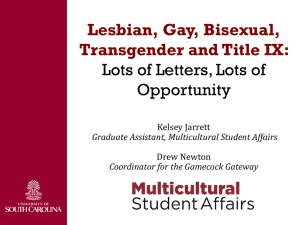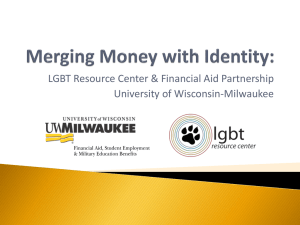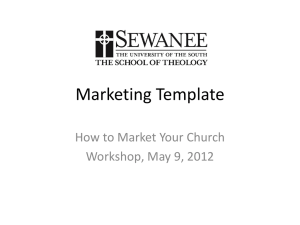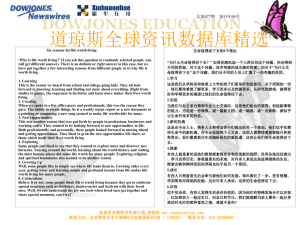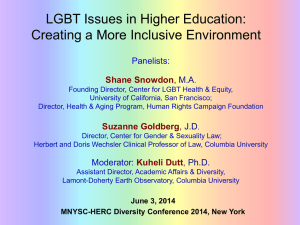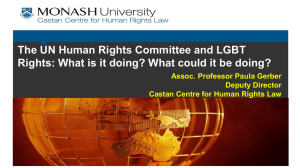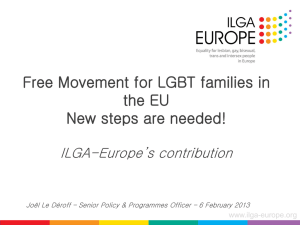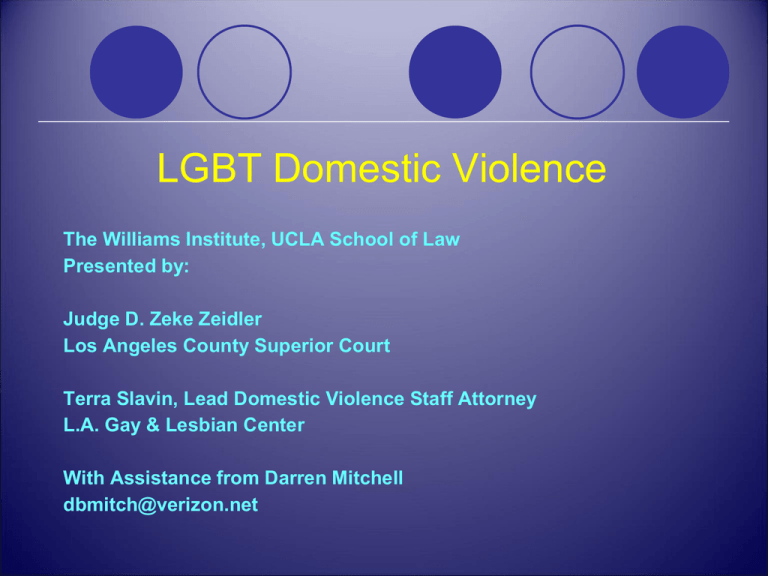
LGBT Domestic Violence
The Williams Institute, UCLA School of Law
Presented by:
Judge D. Zeke Zeidler
Los Angeles County Superior Court
Terra Slavin, Lead Domestic Violence Staff Attorney
L.A. Gay & Lesbian Center
With Assistance from Darren Mitchell
dbmitch@verizon.net
What we’ll explore today:
• Demographic info: LGBT people in our courtrooms
• Definitions of terms: a common understanding
• Scenario to examine LGBT abusers’ tactics
• Four challenges judges face in LGBT DV cases:
the myth of “mutual abuse,” victims who present
poorly, creating a bias-free courthouse, and
identifying appropriate services
• Use of civil protection orders to protect LGBT
survivors
Defining the Problem:
Sexual Orientation.
Who Is In Your Courtroom?
Self-Test
Common Assumptions
Media images of lesbians and gay men
create the impression that most of them
are white urban dwellers
Many assume they also have high
incomes and are preoccupied with
shopping for expensive clothes, preparing
gourmet food, or eating at upscale
restaurants
Self-Test Objective:
A variety of stereotypes and
misconceptions exist about lesbian and
gay persons and their families
After this session, you will have some
facts taken from US Census data about
this understudied population
Here’s a quiz to test your knowledge of
lesbians and gay men in the United States
I. Approximately what fraction of
the U.S. population identifies as
gay, lesbian, or bisexual?
a. 1-2 percent
b. 3-5 percent
c. 8-12 percent
d. Nearly 25 percent
I. Approximately what fraction
of the U.S. population
identifies as gay, lesbian, or
bisexual?
a)
b)
c)
d)
1-2 percent
3-5 percent
8-12 percent
Nearly 25 percent
Sexual orientation includes a complex
interaction of identity, behavior, and desire
Behavior
Identity
Desire
General Social Survey (2008)
Nearly 10% of adult men and 8% of adult women have
had at least one same-sex experience since age 18
1.5% of these men and 1.9% of the women identify
themselves as gay or lesbian
0.7% of men and 1.5% of women identify as bisexual
II. How many same-sex couples were
identified in the United States in
2008?
a)
b)
c)
d)
125,568
340,332
564,743
835,324
II. How many same-sex couples were
identified in the United States in
2008?
a)
b)
c)
d)
125,568
340,332
564,743
835,324
Census Bureau data can be used to
study same-sex (gay/lesbian) couples
Census does not ask sexual
orientation
A householder identifies
his/her relationship with
each individual in the house
Choices include
husband/wife, unmarried
partner, roommate,
unrelated adult
Same-sex husbands, wives,
or unmarried partners are
understood to be gay or
lesbian couples
III. In 2008, what portion of U.S.
Congressional Districts included at
least one same-sex couple?
a)
b)
c)
d)
35 percent
52 percent
78 percent
100 percent
III. In 2008, what portion of U.S.
Congressional Districts included at
least one same-sex couple?
a)
b)
c)
d)
35 percent
52 percent
78 percent
100 percent
All places are not created equal
(at least where same-sex couples are concerned)
IV. In 2008, what percentage of samesex couples in the U.S. have
children under age 18 in the home?
a)
b)
c)
d)
5 percent
11 percent
21 percent
43 percent
IV. In 2008, what percentage of samesex couples in the U.S. have
children under age 18 in the home?
a)
b)
c)
d)
5 percent
11 percent
21 percent
43 percent
Increasing numbers of same-sex
couples are raising children
Nationally, 21 percent of same-sex couples are
raising children
That figure was less than 16 percent in 1990
In Census 2000, more than 93 percent of U.S.
counties included a same-sex couple raising a
child under age 18
An estimated 120,000 same-sex couples are
raising nearly 250,000 children.
Of the same-sex couples raising children, more
than two-thirds are female couples
V.
In 2008, married couples with children had an
average of 1.9 children under age 18 per
household. On average, how many children
did same-sex couples have?
a)
b)
c)
d)
1.0
1.4
1.8
2.7
V.
In 2008, married couples with children had an
average of 1.9 children under age 18 per
household. On average, how many children
did same-sex couples have?
a)
b)
c)
d)
1.0
1.4
1.8
2.7
Couples with children share
similar characteristics
Census 2000
Different-sex married
couples
Same-sex
couples
Number of children
1.9
1.8
Average age (parents)
40.5
39.0
Children under age 5
40%
37%
VI. In Census 2000, which state(s) ranked
among the top ten in the proportion of
same-sex couples raising children?
a)
b)
c)
d)
Utah
California
Mississippi
South Carolina
VI. In Census 2000, which state(s) ranked
among the top ten in the proportion of
same-sex couples raising children?
a)
b)
c)
d)
Utah
California
Mississippi
South Carolina
Same-sex couples in the South
have high rates of child-rearing
The top ten states are
1. Mississippi
2. South Dakota
3. Alaska
4. South Carolina
5. Louisiana
6. Alabama
7. Texas
8. Kansas
9. Utah
10.Arizona
California = 32nd, New York = 30th, Ohio = 33rd,
Pennsylvania = 34th, Washington = 49th
VIII In 2008, 37 percent of the children being
raised by married couples in the U.S. were
non-white. What percentage of children being
raised by same-sex couples is non-white?
a)
b)
c)
d)
10 percent
27 percent
44 percent
95 percent
VIII In 2008, 37 percent of the children being
raised by married couples in the U.S. were
non-white. What percentage of children being
raised by same-sex couples is non-white?
a)
b)
c)
d)
10 percent
27 percent
44 percent
95 percent
Many same-sex couples are
racial/ethnic minorities
In the United States, same-sex couples
raising children are more likely than their
married counterparts to be non-white
35 percent compared to 32 percent
IX
In 2008, the median household income of
married couples with children in the U.S. was
$78,000. What is the comparable figure of
same-sex couples raising children?
a)
b)
c)
d)
$96,200
$77,100
$66,500
$50,000
IX
In 2008, the median household income of
married couples with children in the U.S. was
$78,000. What is the comparable figure of
same-sex couples raising children?
a)
b)
c)
d)
$96,200
$77,100
$66,500
$50,000
Same-sex couples with children are
relatively economically disadvantaged
Differences in household income occur among
all racial/ethnic groups raising children
Different-sex married
Same-sex
White
$85,000
$80,000
African-American
$68,200
$37,000
Latino/a
$52,000
$52,000
Asian/Pacific Is.
$89,500
$65,000
Definition of Terms
• Sexual orientation: a person's emotional,
romantic and/or sexual attraction to
individuals of a particular gender.
• Gender identity: describes the gender with
which a person identifies (i.e., whether one
perceives oneself to be a man, a woman, or
describes oneself in other ways).
Sexual Orientation
L: Lesbian- A woman who is predominately or exclusively
attracted to women emotionally, physically, spiritually and/or
sexually.
G: Gay – A term identifying a man who is predominantly or
exclusively attracted to men emotionally, physically, spiritually
and/or sexually. Also sometimes used as a blanket term ("the
gay community").
B: Bisexual – A term identifying a person who is attracted to
men and women emotionally, physically, spiritually and/or
sexually.
Note: The L, G and B relate to a person’s sexual orientation.
Gender Identity
The T: Transgender – An umbrella term used to
describe a continuum of individuals whose gender
identity and how its expressed, to varying
degrees, does not correspond to their biological
sex.
Note: The T relates to a person’s gender
identity.
Some common terms under the umbrella:
Transexual, Male to Female (MTF), Female to
Male (FTM), Cross Dresser, Drag Queen/King
What’s most important?
LGBTQ individuals are incredibly diverse
and come from all racial, ethnic and socioeconomic backgrounds.
Respect how people self-identify however
that may be: queer, genderqueer, a man who
sleeps with men (MSM), a woman who
sleeps with women (WSW), questioning,
pansexual, two-spirit, dyke, androgyne,
asexual, bear, stud, etc...
Definition of Domestic Violence
A pattern of abusive behavior in
any relationship that is used by
one partner to gain or maintain
power and control over another
intimate partner.
“Coercive control”
(Evan Stark (2009) “Rethinking Custody Evaluation
in Cases Involving Domestic Violence,” Journal of
Child Custody,6:3,287):
“A growing body of research suggests that in an
estimated 60% to 80% of abuse cases where
outside help is sought or required, the physical
and sexual assaults are accompanied by a
combination of tactics to intimidate, humiliate,
degrade, exploit, isolate, and control a partner.”
“Coercive control”:
“Well over 90% of all domestic violence incidents are
relatively minor from a medical or criminal justice
perspective. This is even more true in cases of coercive
control where the typical pattern involves frequent or
routine, but typically low level violence such as pushes,
slaps, hair pulling, kicks, and grabbing, events that are likely
to remain invisible if radar is set to pick up only injurious
violence. The significance of these events lies in their
cumulative effect on a person’s sense of autonomy
and on their decision-making, an outcome called
‘‘entrapment,’’ rather than in their proximate physical
consequence.”
Prevalence of Domestic Violence in
LGBT Relationships
• Current research indicates that the prevalence
of domestic violence in LGBT relationships is
comparable to that in heterosexual
relationships (25-33%)
• The dangerousness presented by LGBT
abusers is also comparable.
“You fight like a girl!”
- Arm wrenched out of socket.
- Hit in the head by a brick
- Eardrum ruptured by blows to the head with a
shovel.
- Gunshot wound to shoulder - not allowed to
seek medical assistance for hours.
- Ribs broken and then gun held to head for 2
hours
- Forced to kneel on broken glass.
If you heard these stories what gender
would think the survivor was? What
gender would you think the batterer was?
These incidences have been reported to DVLAP staff members by
female, male and transgender survivors.
Scenario:
Edward and Daniel
Abusers' Tactics
What forms of abuse can you identify in
the scenario?
What other forms of abuse do you think
may be present or are likely to occur in the
future?
Abusers’ Tactics
Abusers' Tactics
1. Using Intimidation;
2. Using Emotional
Abuse;
3. Using Isolation;
4. Denying,
Minimizing, and
Blaming
5. Using the
Children;
6. Using Economic
Abuse; and
7. Using Coercion
and Threats.
Using Coercion/Threats:
• Threats to out (sexual orientation/HIV status) to family,
friends, employers, places of worship: threat of job/housing
loss, excommunication, alienation, etc.
• Edward threatens to tell the owner of the bakery that Daniel
is gay; he reminds Daniel that he’ll have nowhere to stay if
he loses his job and Edward does not provide for him
Using Emotional Abuse:
• Making the victim feel guilty/ridiculing him/her for not being
out to family, friends, work, etc.
• Reinforcing internalized homophobia
• Edward tells Daniel that he is suicidal because he cannot deal with
his sexual orientation and that he is “damaged goods that no one
else will take pity on”
Using Isolation:
• Using sexual orientation to alienate survivor from family,
community, institutions; exploiting homophobia
• Saying that no one will believe the survivor because she or
he is LGBT
• Saying only the abuser will love the survivor because
survivor is LGBT (especially for trans/elder survivors)
• Edward warns Daniel that he will lose all of his friends if he
leaves, and that they will not believe that Edward has been
abusive; Edward warns Daniel that he has nowhere to go
because his family has rejected him
Denying, Minimizing, Blaming:
• Saying all LGBT relationships are like this (especially for
individual in first relationship)
• Accusing survivor of “mutual” abuse
• Saying all men are violent in relationships; saying women
can’t abuse each other
• Edward tells Daniel that other gay couples “fight just as much as
we do” and that he’s just too inexperienced to know it
• He also tells Daniel that he is just as responsible for what is
happening as Edward
Using Children:
• Threatening to out survivor to child protection, other authorities, or
other parents and to have children removed
• Threatening to deny contact/custody to non-biological parent, where
survivor has no custody rights
• Edward knows that Daniel has no legal rights to the child, so
he constantly threatens Daniel that if he leaves he’ll never
see her again
Using Privilege:
• Exploiting homophobic systems to reinforce survivor’s subservient
status, especially where abuser can “pass” as non LGBT
• Edward, with his daughter from a previous marriage to a
woman, does not appear to be gay; he tells Daniel that
because, except at work, he dresses and acts gay, the police
won’t help him, but that if Edward calls them he’ll get help
Using Economic Abuse:
• Threatening to out survivors to employers, housing
authorities, etc.
• Keeping name off joint assets, exploiting inability to
marry
• Denying survivor domestic partner benefits
• Committing identify theft
• In addition to threatening to out Daniel at work, Edward has
managed to take over all of the couple’s finances and to
put all of their major purchases in his name only; he tells
Daniel that if he leaves, he has no right to anything they
bought because there is no such thing as “marital property”
in a gay relationship.
LGBT Abusers' Tactics: Beyond the
Power and Control Wheel
Physical and Sexual Abuse:
• Forcing survivor to have sex to prove survivor is a “true”
LGBT person
• Using shame surrounding LGBT sexuality to keep survivor
from discussing sexual abuse
• Hiding/destroying survivor’s hormones (for trans survivors) or
HIV/AIDS medications (for HIV+ survivors)
• HIV transmission through coercion, concealment, or assault
• Increasing survivor’s vulnerability to hate crimes
Exploiting Vulnerabilities:
• Using own vulnerabilities (e.g., HIV+ status; not being “out”)
to obligate/coerce survivor into staying with, caring for,
prioritizing abuser
LGBT Abusers' Tactics: Beyond the
Power and Control Wheel
Leveraging Societal Discrimination/Homophobia:
• Exploiting homophobia of police, hospital personnel,
service providers, justice system
Additional Barriers Abusers Exploit:
• Inability of gay men/trans people to use most shelters
• Ease with which women can access shelters; with
which same-sex abusers can access hospital rooms,
bathrooms, and other “safe” spaces
• Small, insular communities: difficulty in finding safety;
ease with which survivor can be ostracized
• Immigration status: abusers threaten to report
undocumented victims; undocumented abusers
exploit vulnerable status
LGBT Domestic
Violence in the
Courtroom:
Challenges for Judges
Challenges for Judges
The Myth of “Mutual Abuse”:
Identifying the True Victim
Victims who present poorly
Creating a bias-free courthouse
Identifying appropriate services
The Myth of “Mutual Abuse”
• Daniel is physically much larger than Edward
• Edward says that Daniel usually initiates the
“fighting” and that he must defend himself
physically
• Edward plays into myths about gay
relationships by claiming that the fighting is
typical
• Edward denies or minimizes the non-physical
abuse (economic abuse, isolation, etc.)
• LGBT abusers can make the domestic
violence look “mutual”
-it’s not mutual, if one of the parties has not
exhibited a pattern of abusive behavior to
gain or maintain power and control
• LGBT (and non-LGBT) victims may “use
violence” for a range of reasons, including as
a way to survive the abuse
• Not
looking deeper can result in
damaging collateral consequences:
-Dual arrests
-Cross protection orders
-Loss of employment
-Loss of public benefits
How to look “deeper” -Assessment Tools
Ask questions about:
• The context of the abuse
• The intent of the abuse
• The effect of the abuse
Assessment tools and training on their use are
available from LGBT DV organizations
(Including the Northwest Network of Bi, Trans, Lesbian, and Gay
Survivors of Abuse and The Network LaRed)
Victims who
“present” poorly
LGBT DV in the Courtroom
As a result of all of the barriers we discussed, victims
may not present well in our courtrooms:
Cases may come to you with little or no evidence of
abuse beyond the victim’s testimony:
No or shoddy police reports
Dual arrests/cross filed protection order petitions
No or little medical evidence
No witnesses
Although victims allege long-standing abuse, they
have never sought help in the past
• Daniel never reported the abuse to the police
• A neighbor called 911 once, but the police refused to
complete a report because they claimed that they could
not determine a primary aggressor and that it simply
looked like a fight between two men
• Edward once slashed Daniel with a knife, but when he
sought medical treatment he reported it as an accident at
work because he did not want to come out to the doctor;
he never brings this to the Court’s attention
• Daniel has no witnesses to support his allegations
LGBT DV in the Courtroom
Previous attempts to seek help may have resulted
in no finding of abuse or disbelief on the part of
“the system”
Victims may appear to be trying to conceal their
sexual orientation or gender identity (due to
perceptions of how they will be treated or to
previous help-seeking experiences)
Seem highly distrustful/hesitant to be forthcoming with
information
In addition, LGBT people may face
additional hurdles in court
Court forms, procedures, etc. may require the
victim to come out
Especially difficult where victim cannot obtain expert
representation (or any representation) and must
navigate the system pro se
Court personnel (clerks, bailiffs, etc.) may lack
training and act on implicit bias to mistreat LGBT
people
Judges may do the same
Toward a bias-free courthouse –
Judicial Canons
ABA Model Code of Judicial Conduct (2007)
RULE 2.3
Bias, Prejudice, and Harassment
(A) A judge shall perform the duties of judicial office, including
administrative duties, without bias or prejudice.
(B) A judge shall not, in the performance of judicial duties, by
words or conduct manifest bias or prejudice, or engage in
harassment, including but not limited to bias, prejudice, or
harassment based upon race, sex, gender, religion,
national origin, ethnicity, disability, age, sexual orientation,
marital status, socioeconomic status, or political affiliation,
and shall not permit court staff, court officials, or others
subject to the judge’s direction and control to do so.
ABA Model Code of Judicial Conduct (2007)
RULE 2.3
Bias, Prejudice, and Harassment
(C) A judge shall require lawyers in proceedings before
the court to refrain from manifesting bias or prejudice,
or engaging in harassment, based upon attributes
including but not limited to race, sex, gender, religion,
national origin, ethnicity, disability, age, sexual
orientation, marital status, socioeconomic status, or
political affiliation, against parties, witnesses, lawyers,
or others.
Toward a bias-free courthouse –
Judicial Leadership
Amend forms, procedures, etc. to allow victims to seek legal
relief without coming out
In some states, the victim can check a box labeled “room-mate”
without revealing the nature of the relationship
Train all court personnel on how to dismantle barriers to
access for LGBT people
Establish and enforce rules regarding offensive conduct and
statements by staff and others in the courthouse
Recognize and minimize the effects of implicit bias in
yourself and others with whom you work
Use of domestic
violence protective
orders to protect LGBT
survivors
Effective Protection Orders
Safety provisions
Safety provisions (stay-away, no-contact, no abuse, no
harassment, no stalking, etc.) should be specific and tailored
to the particular relationship, taking into account the tactics
used by LGBT abusers; Examples include:
o Prohibiting the abuser from outing the survivor in any
context: (e.g., “Respondent shall not disclose information
about Petitioner’s sexual orientation or gender identity to
others with the intent of harassing, isolating, embarrassing,
or otherwise harming the Petitioner.”)
•Economic relief – Where appropriate, judges should include
appropriate provisions granting economic relief, which is especially
important for LGBT survivors who may not have protections available to
heterosexual married survivors
•Housing relief - Judges should consider including housing relief
(exclusion of abuser; abuser required to pay rent and utilities; etc.),
especially important due to housing discrimination against LGBT
survivors
•Custody and visitation issues - Judges should issue temporary
custody provisions within protection orders in favor of the survivor, where
the survivor has custody rights (biological or adoptive parent)
•Use Catch-all provisions where available to grant requested relief if it
would otherwise not be available given LGBTQ nature of relationship.
Mutual orders
Unless supported by the facts, judges should not
issue mutual protection orders (single order with
relief against petitioner as well as respondent) for
several important reasons; especially problematic in
LGBT context where dual arrests or non-action by
police already is prevalent
Transgender victims:
•Judges should permit the transgender person
to use his or her chosen name and gender
identity in the order
•If necessary, “also known as” or “formerly
known as” language should be employed
Effective Services: An Opportunity for
Judicial Leadership
DV advocacy services:
Are there services in your community for LGBT
victims; will programs assist male victims in samesex relationships?
Are shelters limited to heterosexual, nontransgender women?
Batterers’ intervention programs:
One size does not fit all—is there a program in
your community that has the expertise to serve
LGBT clients?
Will the program even permit perpetrators of
same-sex DV to participate?
How do you judge the competence and
effectiveness of such programs
Some thoughts from judges
WA State Judges’ Benchguide on Sexual Orientation and the law
•WA State Judges’ Benchguide on Sexual Orientation and
the law
Some Resources
The Williams Institute
http://www.law.ucla.edu/williamsinstitute/home.html
The Williams Institute, UCLA School of Law is a national
think tank dedicated to sexual orientation law and public
policy. It advances law and public policy through rigorous
and independent research and scholarship.
Voice: (310) 267-4382
Fax: (310) 825-7270
American Bar Association – Commission on Domestic Violence
http://www.americanbar.org/groups/domestic_violence/resourc
es/resources_for_attorneys/marginalized_communities/lgbtq.ht
mll (The ABA CDV has a LGBT DV Toolkit and other specific
resources for legal professionals).
L.A. Gay & Lesbian Center – Domestic Violence Legal
Advocacy Project: 323-993-7649 or www.lagaycenter.org
National Coalition of Anti-Violence Programs (NCAVP):
(212) 714-1184 or www.avp.org/ncavp.htm


